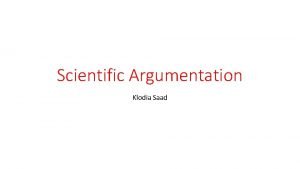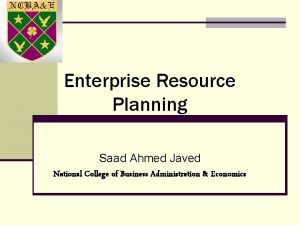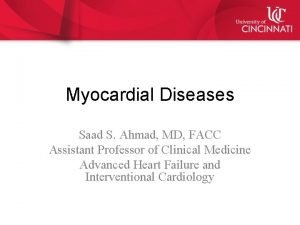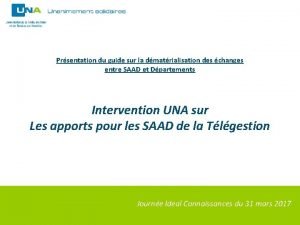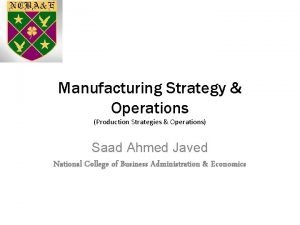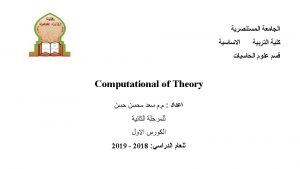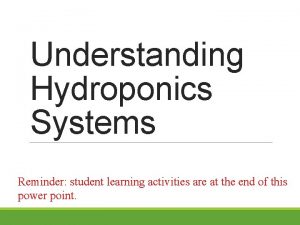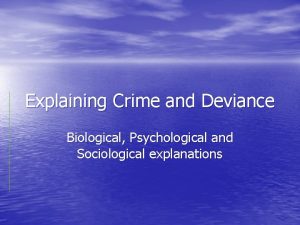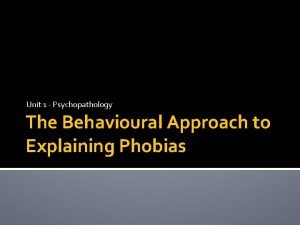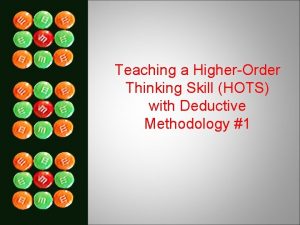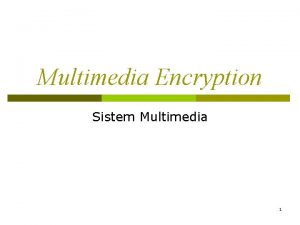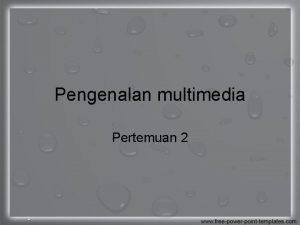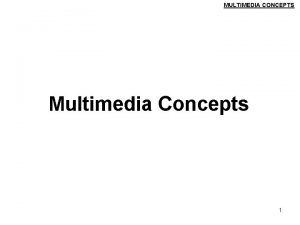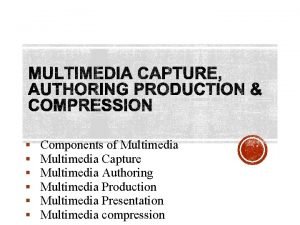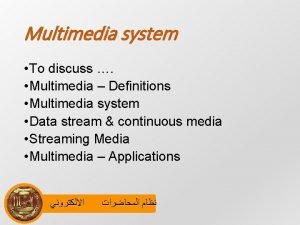EXPLAINING PERFORMANCE USING A MULTIMEDIA TOOL Raafat Saad





























- Slides: 29

EXPLAINING PERFORMANCE USING A MULTIMEDIA TOOL Raafat Saadé, Fassil Nebebe and Dennis Kira In. Site 2019 Conferences: Jerusalem Jun 30 - Jul 4 2019, Jerusalem, Israel

Agenda § Background § Research Model ü Constructs • Perceptions • Cognitive absorption • Proposed model ü Hypotheses and proposed model ü MEL tool ü Survey Instruments ü MEL usage and results ü Explanations ü Additional References

Background § Learning and Teaching Environment ü Multimedia tools can be used to enhance student motivation, participation, and engagement. The success of Multimedia Enhanced Learning (MEL) is fostering the creation of new educational resources and changing the learning paradigm as it impacts the roles between teachers and students. ü Stakeholders are not capitalizing on its potential to offer different and improved ways to disseminate and acquire, to evaluate what has been acquired, and to assimilate knowledge. ü Evaluating and Understanding of new aspects and pedagogies suitable for the virtual environment (Esteban-Millat, et. al. , 2014; Rushby, 2013). ü Theory of flow developed by Csikszentmihalyi (“chicks send me high-lee, ” ) is defined as the holistic experience that people feel when they act with total involvement. 3

Flow 4

PERCEPTIONS § PEU (Perceived Ease of Use), PU (Perceived Usefulness), ATT (Attitudes) and INT (Intention) 5

COGNITIVE ABSORPTION (CA) (Vallerand, 1997, Csikszemtmihalyi, 1990) FI (focused immersion), CON (control), CUR (curiosity), (Hsu & Lu, 2004, Zhu and Morosan, 2014; Bozoglan et al. , 2014; Leong, 2011) TD (temporal dissociation), HE (heightened enjoyment) (Agarwal & Karahanna, 2000) 6

ed Hypotheses § § H 1. Intention to use MEL tool will have a positive effect on Student’s Performance. § § H 3. Attitude will have a positive relationship with Intention to Use the MEL tool. § H 5. the MEL tool. § H 6. Usefulness of the MEL tool. H 2. student’s Performance. H 4. the MEL tool. Cognitive tion § H 7. Use of the MEL tool. § 7

Research Model 8

THE MULTIMEDIA TOOL § Web-based application that manages the knowledge of ERD (Entity-Relation Diagram) § ERD’s design elements (entity, relationships, and cardinalities). § The MEL tool has two major procedures. ü The first is a text and animation based tutorial. This presentation describes the necessary tools and the rules, which govern the design of relationship diagrams. ü The second part of the MEL tool is an ERD problem practice section. In this section the user can build ERD’s using a system that is similar to a CASE tool. 9

INSTRUMENT Construct Perceived Usefulness (PU) Perceived Ease of Use (PEU) Attitude (ATT) Item Measure PU 1 Learning to navigate the MEL is easy for me. PU 2 I find it easy to get the MEL to do what I want it to do. PU 3 It was easy for me to become skillful at using the MEL. PU 4 I find the MEL easy to use. PEU 1 I feel that using the MEL has improved my performance in the Comm 301 course. PEU 2 Using the MEL in the comm 301 course has improved my productivity. PEU 3 Using the MMLS has enhanced my effectiveness in the comm 301 course. PEU 4 I find the MEL useful in the comm 301 program. ATT 1 Using MEL in the Comm 301 course was a good idea. ATT 2 Using MEL in the Comm 301 course was pleasant. ATT 3 Using MEL was beneficial to me in the Comm 301 course. 10

INSTRUMENT Intention to Use (INT) Temporal Dissociation (TD) Focused Immersion (FI) Heightened Enjoyment (HE) INT 1 I intend to use MEL frequently whenever they are available. INT 2 TD 1 I intend to be a heavy user of MEL whenever they are available. Sometimes I lose track of time when I am using the MEL. TD 2 TD 3 Time flies when I am using MEL. Most times when I get on to the MEL, I end up spending more time than I had planned. TD 4 FI 1 I often spend more time on the MEL than I intended. When I am using the MEL I am able to block out most other distraction. FI 2 FI 3 HE 1 While using the MEL, I am absorbed in what I am doing. While using the MEL, I am immersed in the task I am performing. I have fun interacting with the MEL. HE 2 HE 3 Using the MEL bores me. I enjoy using the MEL. 11

Descriptive statistics # Items Mean St Dev Rho 4 PU 3. 28 1. 08 0. 735 3. 24 1. 04 0. 757 3. 37 1. 10 0. 401 3. 68 1. 13 0. 735 2. 974 0. 75 0. 377 3. 10 0. 99 3. 05 0. 93 3. 33 1. 03 4 PEU 2 INT 3 ATT CA 4 TD 3 FI 3 HE 12

MEASUREMENT MODEL Scale Items INT ATT PU PEU CA INT 1 0. 9467 0. 6077 0. 4509 0. 2638 0. 3582 INT 2 0. 9219 0. 5091 0. 3823 0. 2307 0. 3635 ATT 1 0. 5431 0. 8971 0. 5296 0. 4203 0. 4557 ATT 2 0. 5108 0. 8831 0. 5154 0. 4323 0. 4502 ATT 3 0. 5703 0. 9215 0. 6301 0. 4183 0. 3876 PU 1 0. 3701 0. 549 0. 8964 0. 459 0. 3581 PU 2 0. 45 0. 5497 0. 8996 0. 4526 0. 4428 PU 3 0. 3901 0. 547 0. 9212 0. 4517 0. 4176 PU 4 0. 4089 0. 6024 0. 8878 0. 4795 0. 3983 PEU 1 0. 2372 0. 397 0. 4068 0. 8623 0. 212 PEU 2 0. 2271 0. 4053 0. 4291 0. 8709 0. 2644 PEU 3 0. 2377 0. 4324 0. 5157 0. 9101 0. 3461 PEU 4 0. 2429 0. 433 0. 4595 0. 9042 0. 323 TD 0. 2304 0. 2412 0. 2437 0. 1309 0. 6616 FI 0. 2763 0. 3272 0. 2899 0. 2618 0. 7358 HE 0. 3304 0. 4439 0. 4228 0. 298 0. 8025 Table 3: Factor analysis results. 13

Internal Reliabilities Composite Reliability (# of item) INT Cronbach Alpha INT ATT PU 0. 93 0. 85 0. 93 0. 88 0. 60 0. 94 0. 92 0. 45 0. 62 0. 90 0. 94 0. 91 0. 27 0. 47 0. 51 0. 57 0. 39 PEU CA ATT PU PEU CA 0. 78 0. 45 0. 89 0. 33 0. 73 The numbers on the leading diagonal are the square root of the variance shared between the constructs and their measures. Off diagonal elements are the correlations among constructs. For discriminant validity, diagonal elements should be larger than off-diagonal elements. 14

MEL Usage § Students were provided this MEL tool as a resource. Its usage was voluntary. § In the course outline, it was mentioned that one of 4 parts of the final exam will entail a question on the concept of ERDs and that this tool will help them learn it better. Therefore, students may or may not have used it; some may have used it very little and others a lot; and some students used it with attention (in other words by carefully manipulating the ERD symbols and putting serious thought into their decisions to construct the ERD); while others just clicked back and forth until they got the right answer. This varied way in which students may have used the MEL tool may explain why the factor cross-loadings were not as desired. § Therefore, student’s responses to the MEL tool’s usefulness are a reflection of their intentions and to a larger extent even, that of their attitude. This is also evident in Table 4 where the inter-construct correlations for INT, ATT and PU are so close (around 0. 90) and that of CA (0. 73) is significantly different. 15

Measurement Model (Result) 16

ed Hypotheses (from earlier slide) § § H 1. Intention to use MEL tool will have a positive effect on Student’s Performance. § § H 3. Attitude will have a positive relationship with Intention to Use the MEL tool. § H 5. the MEL tool. § H 6. Usefulness of the MEL tool. H 2. student’s Performance. H 4. the MEL tool. Cognitive tion § H 7. Use of the MEL tool. § 17

Hypotheses (some comments) § The model results clearly show strong and significant support to all hypotheses in terms of relationships (as indicated by the path coefficients – numbers on the arrows) with the exception of PEU-ATT, which is significant, but at a value of -0. 065 (negligible). The strongest relationship is that of ATT-INT which is -0. 540. This model results shows some interesting trend in that CA influences positively beliefs (PU and PEU) while beliefs (primarily PU and ATT) have a negative influence on INT, and in turn INT negatively influencing PER. This suggests that the more engaged (through the experience of flow as measured by CA) the 18

Explanations § The model results clearly show strong and significant support to all hypotheses in terms of relationships (as indicated by the path coefficients – numbers on the arrows) with the exception of PEU-ATT, which is significant, but at a value of -0. 065 (negligible). § The strongest relationship is that of ATT-INT which is -0. 540. This model results shows some interesting trend in that CA influences positively beliefs (PU and PEU) while beliefs (primarily PU and ATT) have a negative influence on INT, and in turn INT negatively influencing PER. ü This suggests that the more engaged (through the experience of flow as measured by CA) the student is while using the MEL tool, the stronger their beliefs in the ease of use and usefulness of the tool. However, contrary to what we would expect, when a student’s belief in the usefulness of the MEL tool increases, their intentions to use it further decreases. This may be explained in terms of confidence in the knowledge gained. That is, as students continue to use the MEL tool, they gain confidence in the knowledge gained and tend to feel that using it further is less necessary. In other words, students who use the MEL tool more, intend to stop using it because probably they felt that they have achieved their goal of solving ERD problems (in this case). This is the effect observed from using the tool successfully. Following up on this trend to the INT-PER relationship, we find out that students who intend to use it more perform less, or put differently, students who intend to use it less perform better. This actually supports the rationalization that preceded it in the PU-INT relationship, and goes as follows: student who use the MEL more have less intentions to use it further THAN students who have less intentions to use it further (as a result of using the MEL enough to have learned all that it has to offer) perform better. This conclusion is a great insight to how multimedia can be integrated into pedagogy. 19

Regression Models PU – PER PEU – PER INT – PER CA – PER ATT – PER 0. 243 6 -0. 185 3 -0. 246 6 0. 022 0. 1 -0. 052 0. 3 20

Factor Analysis 21

Factor Analysis § The results of the factor analysis for the new model show that all factors do have the prescribed validity and that the issue of multiple loadings seem to been caused by INT as the factor loading results are what we would expect them to be. 22

Conclusions § The results of this study provide a number of interesting insights to the use of multimedia enhanced learning tools: ü (1) Cognitive absorption (CA) was shown to be a significant antecedent to beliefs in the Multimedia Enhanced Learning (MEL) context; ü (2) Intention (INT) plays an important moderating role in the support of the model hypotheses; ü (3) the model without the INT construct provides better psychometric properties of the model; ü (4) PU influences INT contrary to what we would expect, however, in the context of MEL tool, the results are true to student’s experiences in the learning context; ü (5) following (4), the negative influence of INT on PER further supports student’s learning experience; ü (6) students who used the MEL tool performed around 13% better from those who did not use it; and ü (7) all possible investigation into PER explanation rendered weak results, alluding to the need to identify and explore other constructs to fill the gap between INT and PER. 23

Conclusions (continue) § We think of the practitioner herein as the teacher and designer of the course and MEL tool, and as such, we attempt to connect the implications of the results to the practitioner’s role. ü First, it is clear (although more refinement to the research is needed) and accepted that multimedia has the strong potential to enhance the student’s learning experience. Due to the nature of the multimedia technologies, a strong design focus may be achieved to considering the integration of multimedia elements that foster the creation of flow. ü Flow can then be measured by the CA construct as shown in this study. The introduction of flow in the MEL tool can be done by mapping elements of game and process. ü This high-level design considerations are to be implemented to specific parts of the subject matter and those that benefit from multimedia need to be identified by the practitioner 24

Question? 25

Additional References § Joo, Y. J. , Lim, K. Y. , & Kim, S. M. (2012). A Model for Predicting Learning Flow and Achievement in Corporate e-Learning. Educational Technology & Society, 15 (1), 313– 325 § A Cross-Cultural Study of Flow Experience in the IT Environment: The Beginning, Alexander E. Voiskounsky Csikszentmihalyi, M. : Beyond boredom and anxiety: Experiencing flow in work and play. Jossey-Bass, San. Francisco (first published in 1975) (2000) Csikszentmihalyi, M. : Flow: The psychology of optimal experience. Harper and Row, New York, NY (1990) EGame. Flow: A scale to measure learners’ enjoyment of e-learning games, Fong-Ling Fu a, Rong-Chang Su a, Sheng-Chin Yu, Computers & Education 52 (2009) 101– 112 Enhancement of Learning Experience Using Skill-Challenge Balancing Approach, Norliza Katuk 1, Ruili Wang 1, and Hokyoung Ryu, D. Wang and M. Reynolds (Eds. ): AI 2011, LNAI 7106, pp. 707– 716, 2011. Flow in Computer-Mediated Environments: Promises and Challenges by C. M. Finneran and P. Zhang, Impact of media richness and flow on e-learning technology acceptance, Su-Houn Liu, Hsiu-Li Liao, Jean A. Pratt, Computers & Education 52 (2009) 599– 607 Incentives and flow experience in learning settings and the moderating role of individual differences, Julia Schüler & Stefan Engeser, in: M. Wosnitza, S. A. Karabenick, A. Efklides, & P. Nenniger (Eds. ), Contemporary Motivation Research: From Global to Local Perspectives. Göttingen: Hogrefe The Importance of Motivation: Integrating Flow Theory into Instructional Design Tom S. Chan, Terence C. § § § § Ahern § Meaningful Interaction in Virtual Learning Environments, Erik Champion 26

Additional References (continue) § § § § § Li, J. S. , Xu, H. , & Chen, S. S. (2012). The effect of flow and motivation on users’ learning outcomes in Second Life. Journal of Educational Technology Development and Exchange, 5(1), 95 -108. Technoflow among Spanish and Swedish students: A Confirmatory Factor Multigroup Analysis, Alma María Rodríguez Sánchez 1, Eva Cifre Gallego 1, Marisa Salanova Soria y Carl Åborg, anales de psicología 2008, vol. 24, nº 1 (junio), 42 -48 The Effects of Learning Style and Flow Experience on the Effectiveness of Elearning, Wen Jia Rong and Yang Szu Min, Proceedings of the Fifth IEEE International Conference on Advanced Learning Technologies (ICALT’ 05) The Flow of Online Learning with Music and Animation, Sue Grice and Dr Janet Hughes To Flow and Not to Freeze: Applying Flow, Experience to Mobile Learning, Jungho Park, David Parsons, and Hokyoung Ryu, IEEE TRANSACTIONS ON LEARNING TECHNOLOGIES, VOL. 3, NO. 1, JANUARY-MARCH 2010 Finding an Optimal Learning Path in Dynamic Curriculum Sequencing with Flow Experience; Norliza Katuk 1 and Hokyoung Ryu 2010; International Conference on Computer Applications and Industrial Electronics (ICCAIE 2010), December 5 -7, 2010, Kuala Lumpur, Malaysia Progressive assessment of student engagement with web-based guided learning; Katuk, Norliza. Interactive Technology and Smart Education; Bingley Vol. 10, Iss. 2, (2013): 116 -129. DOI: 10. 1108/ITSE -11 -2012 -0023 Learning Content Sequencing in an Educational. Environment According to Student Needs. Ana Iglesias, Paloma Martínez, Ricardo Aler, and Fernando Fernández Discovering the campus together: A mobile and computer-basedlearning experience. Mar Pe rez-Sanagustı na, n, Gustavo Ramirez-Gonzalezb, c, Davinia Herna ndez-Leoa, Mario Mun oz-Organerob, Patricia Santosa, Josep Blata, Carlos Delgado Kloos; Journal of Network and Computer Applications 35 (2012) 176– 18 A New Sequencing Method in Web-Based Education Luis de-Marcos, José J. Martínez, José A. Gutiérrez, Roberto Barchino, José M. Gutiérrez; 2009 IEEE Congress on Evolutionary Computation (CEC 2009) 27

Additional References (continue) § Go With the Flow: Engagement Factors for Learning in Second Life Karen Cooper, Ph. D; Proceeding Spring. Sim '10 Proceedings of the 2010 Spring Simulation Multiconference Article No. 39 § Ruili Wang, Hokyoung Ryu & Norliza Katuk ; ASSESSMENT OF STUDENTS’ COGNITIVE– AFFECTIVE STATES IN LEARNING WITHIN A COMPUTER-BASED ENVIRONMENT: EFFECTS ON PERFORMANCE; Journal of ICT, 14, 2015, pp: 153– 176 Wan Nooraishya, W. A. , & Nazlan, M. A. (2018). The impact of Persuasive Technology on User Emotional Experience and user experience Over Time. Journal of Information Conmunisersion Technology, 17(4), 601 -628 Progressive assessment of student engagement with web-based guided learning; Katuk, Norliza. Interactive Technology and Smart Education; Bingley Vol. 10, Iss. 2, (2013): 116 -129. DOI: 10. 1108/ITSEIndicatorsof. Student. Satisfactionin. Postgraduate. Blended. Learning. Programmes: Key Messages from a Survey Study. Sinead Hahessy, Eimear Burke, Evelyn Byrne, Frances Farrelly, Marcella Kelly, Brona Mooney, Pauline Meskell; AISHE-JVolume 6, Number 3 (Autumn 2014) § § § 28

END 29
 Raafat risk analysis model
Raafat risk analysis model Klodia saad
Klodia saad Saad ahmed economics
Saad ahmed economics Is an extended erp module
Is an extended erp module Dr sadia saad
Dr sadia saad Ryan saad
Ryan saad Kussmaul sign
Kussmaul sign Saad bashir
Saad bashir Télégestion saad
Télégestion saad Manufacturing strategies
Manufacturing strategies Joanne saad
Joanne saad Mohsen hassan
Mohsen hassan Saad azhar saeed ucp
Saad azhar saeed ucp Dr hussein saad
Dr hussein saad Saad alshahrani
Saad alshahrani Saad ahmed javed
Saad ahmed javed Multimedia becomes interactive multimedia when
Multimedia becomes interactive multimedia when Media classification
Media classification Chapter 1 introduction to multimedia
Chapter 1 introduction to multimedia Esa multimedia.esa.int./multimedia/virtual-tour-iss
Esa multimedia.esa.int./multimedia/virtual-tour-iss Hydroponics worksheet answers
Hydroponics worksheet answers Explaining voltage
Explaining voltage It tells how something works or why something happens
It tells how something works or why something happens Describing trend of a graph
Describing trend of a graph A pamphlet explaining how an unborn child
A pamphlet explaining how an unborn child Biological explanation of deviance
Biological explanation of deviance Templates for introducing quotations
Templates for introducing quotations Quoting sentence starters
Quoting sentence starters Mowrer's two process model
Mowrer's two process model Explaining patterns hots
Explaining patterns hots

